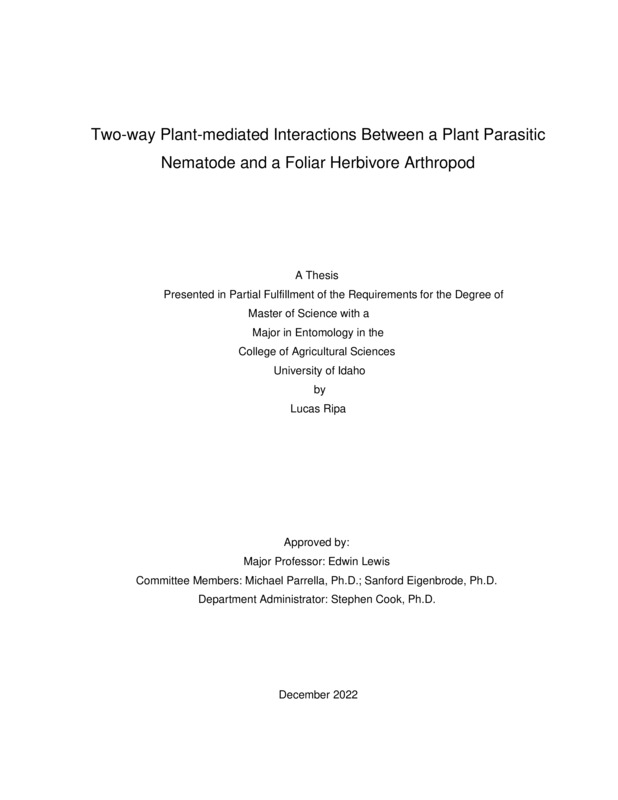Two-way Plant-mediated Interactions Between a Plant Parasitic Nematode and a Foliar Herbivore Arthropod
Ripa, Lucas . (2022-12). Two-way Plant-mediated Interactions Between a Plant Parasitic Nematode and a Foliar Herbivore Arthropod. Theses and Dissertations Collection, University of Idaho Library Digital Collections. https://www.lib.uidaho.edu/digital/etd/items/ripa_idaho_0089n_12469.html
- Title:
- Two-way Plant-mediated Interactions Between a Plant Parasitic Nematode and a Foliar Herbivore Arthropod
- Author:
- Ripa, Lucas
- Date:
- 2022-12
- Keywords:
- Meloidogyne Nematode RKN Spider Mites Tetranychus TSSM
- Program:
- Entomology, Plant Path & Nematology
- Subject Category:
- Entomology
- Abstract:
-
Interactions between belowground and aboveground heterotrophic communities that have no direct physical contact can be connected through the plant as the mediator of these interactions. Herbivores use different types of cues to find suitable host plants, and plants respond to herbivore attack by producing a suite of defensive compounds that can affect the choice and performance of herbivores. The aim of this study was to explore two-way, plant- mediated interactions between two herbivores: the belowground plant-parasitic root knot nematode (RKN) Meloidogyne incognita (Tylenchida: Heteroderidae), and the two-spotted spider mite, Tetranychus urticae Koch (TSSM) (Acari: Tetranychidae), which is an aboveground folivore. Two different host species were used, Lima bean (LB) (Phaseolus lunatus cv. Henderson), which is an optimal host for TSSM, and tomato (Solanum lycopersicum cv. Rutgers), which is a sub-optimal host for TSSM, but optimal for RKN.For the belowground experiments, to test RKN preference, we used two-way glass olfactometers to determine the response of RKN to a LB plant exposed to TSSM versus a LB plant that was not exposed to TSSM. RKN penetrated the roots of non-exposed plants at a greater rate than the TSSM exposed plants. For the aboveground experiments, we used leaf discs and two-way olfactometers to conduct choice tests of the response by TSSM to an RKN-infected plant at 1, 2 and 25 days post-inoculation (DPI) with RKN against a plant of the same age that had not been exposed to RKN. More TSSM were found on non-infected LB plants compared to RKN-infected plants but only at 25 DPI. On tomato plants, TSSM significantly preferred RKN infected plants at 1 DPI. We also tested the effect of the inoculation on the rhizosphere of tomato plants (1 DPI) of the soil-dwelling entomopathogenic nematode (EPN) Steinernema carpocapsae (Rhabditida: Steinernematidae) and found that TSSM preferred the EPN inoculated plants compared to non-inoculated tomato. We carried out a no-choice performance test for TSSM on both LB and tomato plants to determine the performance of the TSSM on plants inoculated with RKN versus clean plants. There was no observed effect of RKN exposure on TSSM performance. This thesis research shows that plants can mediate interactions between below and aboveground herbivores that share the same plant.
- Description:
- masters, M.S., Entomology, Plant Path & Nematology -- University of Idaho - College of Graduate Studies, 2022-12
- Major Professor:
- Lewis, Edwin
- Committee:
- Eigenbrode, Sanford; Parrella, Michael; Cook, Stephen
- Defense Date:
- 2022-12
- Identifier:
- Ripa_idaho_0089N_12469
- Type:
- Text
- Format Original:
- Format:
- application/pdf
- Rights:
- In Copyright - Educational Use Permitted. For more information, please contact University of Idaho Library Special Collections and Archives Department at libspec@uidaho.edu.
- Standardized Rights:
- http://rightsstatements.org/vocab/InC-EDU/1.0/

